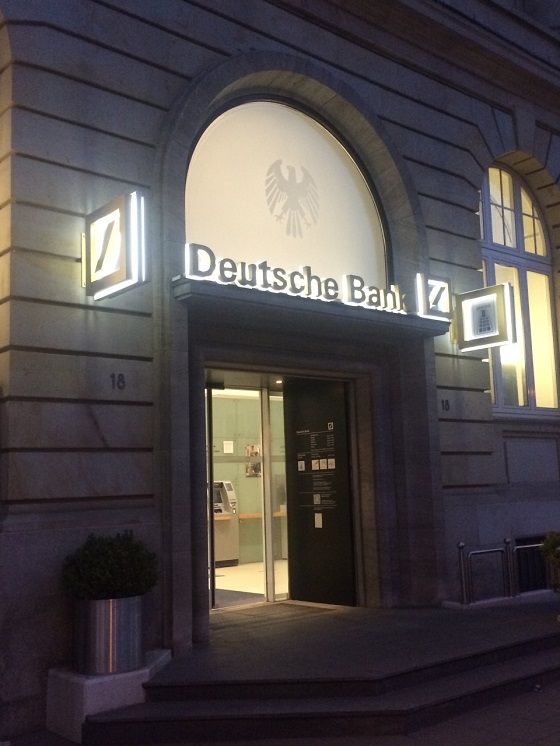by Ronan Manly, BullionStar:

In a brazen development reminiscent of a culprit returning to a crime scene, news has emerged that Germany’s infamous Deutsche Bank is planning to re-join the London Bullion Market Association (LBMA), exactly 9 year after having fled the London gold and silver markets.
According to Bloomberg in an article dated 9 December 2022, titled “Deutsche Bank Seeks to Re-Join Key Gold Trading Club in London”:
TRUTH LIVES on at https://sgtreport.tv/
“Deutsche Bank AG has applied to re-join the London Bullion Market Association – the world’s foremost standard setter for gold trading – as the German lender seeks to expand its trading unit.”
“The lender was previously one of the few clearers of London-based transactions, and also participated in daily price-setting auctions for gold and silver.”
“Membership [of the LBMA] would give Deutsche Bank a seat at the table where decisions are made on how the world’s top precious metals market is run and would eventually allow it to participate in daily price-setting auctions again.”
First Rat Jumped, Ship then Sank
For those who don’t know the background or have forgotten, recall that it was Deutsche Bank’s abrupt and suspicious departure from the London precious metals markets 9 years ago in January 2014 that actually led to the collapse of the old London Gold and Silver Fixings, as well as the sleight of hand switcheroo replacement of these Fixings with the ‘same old wine in a new bottle’ in the guise of the current LBMA Gold Price and LBMA Silver Price auctions.
This unraveling of the old Fixings then triggered the rest of the bullion banks to flee the sinking Fixings ship, which subsequently precipitated class action suits against Deutsche and its bullion bank peers, as well as US Department of Justice prosecution against Deutsche and other bullion bank traders for precious metals price manipulation.
Indeed, in a delicious example of karma and timing, the aftershocks of that period of corruption in the London precious metals markets are still being felt, for it was only this week on 23 January 2023, that the US Supreme court threw out appeals from two former Deutsche precious metals traders (James Vorley and Cedric Chanu) convicted of manipulating gold and silver prices, with the Supreme Court letting those convictions stand.
Not the ideal PR for Deutsche as it seeks to return to the LBMA fold. This is an entire scandal which Deutsche, headquartered in Frankfurt, and a neighbour of the European Central Bank (ECB), would rather sweep under the carpet.
However, instead of sweeping it under the carpet, now is the ideal time to look at how all of this hangs together, how and why Deutsche Bank panicked in 2014 and fled the old Fixings, how this impacted the LBMA Fixings, how Deutsche and its traders were taken through courts, and why at the end of the day the LBMA bullion banks protect their own while pretending to care about free and fair precious metals markets.

BaFin – All Bark no Bite
Many will remember that prior to investigations into precious metals price manipulations, there was LIBOR (London Interbank Offered Rate), a phrase with such negative connotations that it has come to represent the cesspit of investment bank corruption centred in London. Many will also most likely remember that 2012 marked the year in which the full extent of the LIBOR interest rate rigging scandal emerged, a scandal of such proportions that it attracted investigations by many financial regulators around the world into the collusion and manipulations of a mafia cartel of investment banks including Deutsche Bank, UBS, Barclays, JP Morgan, etc. See for example the FT article here.
At that time, regulators also conducted parallel investigations into the manipulation of another key interest rate benchmark, the Euro Interbank Offered Rate, or Euribor, which also involved Deutsche Bank and the same cartels of investment banks.
As 2012 became 2013 and regulatory fines were imposed and investigations trundled on, regulators (always behind the curve) began turning their attention to the manipulation of the precious metals markets benchmarks (the London Gold Fixing, the London Silver Fixing and the GOFO submissions) by the same bullion banks. These regulators included German financial regulator, BaFin.
News of BaFin’s investigation into precious metals manipulation first broke in December 2013, when the Financial Times revealed that BaFin was compelling Deutsche Bank to provide documents, and that the investigations into Deutsche’s precious metals price manipulations had already at that time been going on for a number of months since mid 2013.
According to Reuters, in an article titled “Deutsche Bank under scrutiny in gold price-fixing probe”, from 13 December 2013:
“German banking regulator Bafin has demanded documents from Deutsche Bank as part of a probe into suspected manipulation of benchmark gold and silver prices by banks, the Financial Times reported, citing sources.”
“The examinations were launched several months ago and are still ongoing,” a Bafin spokesman said.”
“Deutsche declined to comment on the FT report.”
Gold Price Manipulation
As to why at that time in 2013 BaFin was concerned about gold and silver benchmark price manipulation, the following quote from consultancy Fideres provides some context.
From the Financial Times on 23 February 23 2014, and quoted on the BullionStar website here:
“Global gold prices may have been manipulated on 50 per cent of occasions between January 2010 and December 2013, according to analysis by Fideres, a consultancy.
The findings come amid a probe by German and UK regulators into alleged manipulation of the gold price, which is set twice a day by Deutsche Bank, HSBC, Barclays, Bank of Nova Scotia and Société Générale in a process known as the “London gold fixing”.
Fideres’ research found the gold price frequently climbs (or falls) once a twice-daily conference call between the five banks begins, peaks (or troughs) almost exactly as the call ends and then experiences a sharp reversal, a pattern it alleged may be evidence of “collusive behaviour”.
“The behaviour of the gold price is very suspicious in 50 per cent of the cases. This is not something you would expect to see if you take into account normal market factors,“ said Alberto Thomas, a partner at Fideres.”

König’s Speech terrified Deutsche
One month after BaFin’s investigation became public knowledge, the president of BaFin, Dr. Elke König, addressed the precious metals manipulation issue directly during a New Year’s press reception speech in Frankfurt on Thursday 16 January 2014, when she said:
“Another topic has remained loyal to us beyond the turn of the year: the allegations of manipulation relating to important reference rates. While the focus was initially on LIBOR , Euribor & Co. , later allegations were made that the determination of reference values for the foreign exchange and precious metals markets was not done properly.
These allegations are particularly serious because, unlike LIBOR and Euribor, such reference values [of FX and precious metals prices] are typically based on real transactions in liquid markets and not on bank estimates.”
“The central reference values seemed beyond any doubt – and now there is a suspicion that they have been manipulated.”
“Who will keep an eye on whether these private supervisory authorities are actually independent? And can such authorities check whether benchmark interest rates are determined in an honest manner? I have my doubts.
The markets for money market transactions, foreign exchange and precious metals are organized in a decentralized manner. Trading takes place bilaterally to a large extent and not on exchanges or exchange-like platforms. Private supervisory bodies can therefore only observe and monitor a relatively small section of what is happening on the market.”
“When it comes to transparency and control, there is still a lot of catching up to do. But the first steps have already been taken, and more are in preparation. In Brussels, for example, an amendment to the market abuse directive is currently being prepared, according to which the manipulation of benchmarks is to be made a punishable offence.”

This speech by BaFin’s president caused direct panic in Deutsche Bank’s Frankfurt headquarters, because less than 24 hours later on 17 January 2014, Deutsche Bank announced that it was withdrawing from the London Gold Fixing and the London Silver Fixing. Perhaps the ‘punishable offence’ was too much for the Deutsche bigwigs.
As Reuters reported in a Friday 17 January 2014 article titled “Deutsche quits gold price-setting as regulators investigate fix”:
“Deutsche Bank will withdraw from gold and silver benchmark price setting, it said on Friday, as European regulators investigate suspected manipulation of precious metals prices by banks.”
“Bafin reiterated in December that besides benchmark interest-rate LIBOR and Euribor rigging by banks, it had been looking at other benchmark-setting processes such as gold and silver price fixings at individual banks.”
The same article also had the interesting revelation that during the same week, Deutsche had suspended a number of its traders in New York:
“On Wednesday [15 January 2014], global investigations into alleged currency market manipulation intensified as U.S. regulators descended on Citigroup’s Canary Wharf London offices and Deutsche suspended several traders in New York, sources told Reuters.”
A Bloomberg report from the same day, Friday 17 January 2014, added that Deutsche would try to sell its seat on the Gold and Silver fixings, and that it would also withdraw from submitting GOFO rates:
“Deutsche Bank AG will withdraw from participating in setting gold and silver benchmarks in London..”
“The German bank will sell its gold and silver fixing membership and stop submitting gold forward offered rates, according to a person familiar with the decision, who asked not to be identified because the information isn’t public.”
A week after Deutsche announced its hastily planned departure from the London Silver and Gold Fixings on 17 January 2014, more bad news hit Deutsche Bank, when it was announced that former senior risk executive William Broeksmit had committed suicide in his London apartment on 28 January 2014.



